2012 Riesling Vinification Notes
2012 “Jean’s Block” Riesling
Vineyard: Our Clone 49 Riesling vines budded out very early in 2012, perhaps two weeks ahead of a normal year. Although this may sound advantageous, it was actually problematic. A sudden frost followed bud-break and many fragile buds were frozen dead. Luckily, we left an extra cane that could be tied down to add a few precious growing shoots to the sparse canopy. The summer growth period proceeded nicely with warm temperatures and little rain. A lighter crop load required less thinning and ripened quickly near the end of August.
Winery: The bulk of our Riesling is purchased by Fielding Estate Winery. In talking with Winemaker (and friend) Richie Roberts, I learned that he likes to harvest Riesling with fairly high acidity to give some vibrant life to the resultant wine. As a bit of a “Riesling rookie” myself, I decided to experiment with this approach and harvest our 2012 crop at a higher TA value than I normally would. We brought in our Riesling on September 13th (earlier than ever) and the pressed juice tasted beautiful! The higher TA meant a juice with lower pH, and consequently a sluggish start to the fermentation. Eventually, with the help of a little extra nutrient, the W15 yeast hit its stride and worked at a nice slow pace over the next month and a half. The fermentation was finally halted on Halloween at a specific gravity of 1.006, a point where I perceived balance on my palate. Over the winter months the wine was protein and cold stabilized prior to coarse filtration. We bottled 96 cases on March 26, 2013. The 2012 “Jean’s Block” Riesling is now available for purchase in our barn.
Price: $25.00
Alcohol: 12.0%
2010 Five Rows Cabernet Sauvignon
One decision a winemaker is faced with as a wine evolves is whether they are making that wine for now or for the future. Variables such as the amount of time spent in barrel, new or previously used oak, French or American oak, health tannin level, acidity and pH all must be addressed. It is where experience really comes into play, as the decisions you make now may lead to the wine being tougher to enjoy in the short term, but hopefully pay dividends later on.
Then there are rare wines like the 2010 Cabernet Sauvignon that are enjoyable now while also exhibiting good aging potential. These wines can make winemakers look very clever, but are probably the easiest to craft. The fruit comes in ripe and clean with ideal parameters and the fermentations go exactly according to plan. After many years of dealing with devilish Pinot Noir, this is a welcome luxury!
The 2010 Cab Sauv was harvested on October 28th and 29th. If we push it, Howie, Wilma and I can hand-harvest and process about 1.5 to 2 tonnes in a day. We normally tackle the Clone 169 block first, then bring in the Old Block Cab on day two. It’s always a relief to get through these two days as the Cab Sauv is the last variety we harvest each year. Needless to say, we slept in on October 30th.
70 picking boxes were harvested from rows 4 and 13 in the Clone 169 Block and 78 boxes from rows 5 and 8 in the Old Block. Following a four-day cold soak, the two bins of fruit were inoculated and warmed to start fermentation. Two yeasts were chosen to work with the specific strengths of each vineyard. The slightly riper Clone 169 fruit was fermented with FX10, known to retain polyphenolic potential (structure and colour), release and bind polysaccharides, and aid in the expression of terroir through minimal “fermentation odour” production. The Old Block was inoculated with CSM, a yeast that specializes in producing intense aromatic profiles of berries, spice and licorice, while concurrently reducing vegetal aromas. A winemaker can only hope that these yeasts live up to such bold claims!
Finished wines were racked to four barrels: Clone 169 to a new Taransaud and two-year-old Billon; Old Block to a two-year-old Taransaud and five-year-old DAMY. Through the years I’ve found that Taransaud barrels do magic for my Cab Sauv. They have a way of “framing” the fruit components of the wine, while contributing just the right amount of oak spice and wood tannin. I usually opt for a tight grain oak, medium toast level with three years of air drying to balance the longer time our red wines spend in barrel. After 24 months in oak, the 2010 Five Rows Cabernet Sauvignon was blended and allowed to bulk age in a tank for five more months. 103 cases were bottled on March 26, 2013. This wine is now available for purchase.
Aromas: blueberry, cherry, Stanley prune, mint
Palate: soft tannin, ripe cherry, savoury mouthfeel/flavour
Cellaring: I personally enjoy drinking this wine now (call it winemaker bias), but it should really be cellared for at least another six months. It has the tannin and structure to age and improve for many years to come, I prefer not to put a limit on it.
Price: $50/bottle
Alcohol: 13.3%
2010 Five Rows Shiraz
Is it a Shiraz or is it a Syrah? The debate over the name of this wine has played out numerous times around our tasting table since we released our first one back in 2008. That 2008 “Shiraz” was a hit with our friends, but most agreed it was more reminiscent of a “Syrah” in style.
I get a kick out of this debate because it brings me nostalgically back to the origins of this grape in our vineyard. We planted Shiraz Clone 100 back in the late 90’s at the request of Creekside Estate Winery, who were bravely setting out to turn Shiraz into a key part of their varietal portfolio and winery identity. Fueled by the knowledge and vision of an enterprising Australian winemaker, Marcus Ansems, my parents agreed to plant the 11 rows of Shiraz that now stand tall along our driveway, across from Wilma’s lavender.
Upon planting, we quickly found out that these vines loved to grow! They shot up like the most vigorous of weeds, making us wonder why few farmers had attempted to grow this grape variety in Niagara before. The first cold winter would provide us the harsh answer to that question.
Just as the vines were starting to mature and bear their first fruit, we were hit with some cold winter conditions that killed nearly half the vines in our new Shiraz vineyard. The Achilles heel of this fast-growing, high-cropping varietal was now all too clear. Should we replant the vineyard or wash our hands with Shiraz altogether? This was a tough call, but in the end we decided to give it one more shot. Thankfully, the winters have been more co-operative since then and we’ve also learned a few tricks in the vineyard to help the vines overwinter better. We switched from a Scott-Henry training system to a more simple, two-arm pendelbogen trellis. More attention was paid to controlling vine vigour through soil nutrition and cropping levels. The vines performed well enough to merit planting 8 more rows of a second Australian Shiraz Clone (#7) in soil with higher clay content to aid in vine development. Both blocks are doing well to this day.
Due to the success of these Shiraz vineyards on our farm and the legitimacy brought to the varietal by Creekside (think luscious Broken Press Shiraz…mmmm!) it was a no-brainer that I would order a large run of labels adorned with “Shiraz” for my 2008 debut. However, as it came time to blend my 2008 Shiraz – the jammy, hot (high-alcohol) and bold notes present in all of our favourite Aussie “critter” wines were nowhere to be found! In fact, every time I sampled these barrels I felt as if I had just tacked up a horse and ridden through a fragrant lavender field, only to suddenly realize I was surrounded by blackberry bushes and Marijuana plants (for the record this has never happened…yet). Alas, despite what thousands of freshly printed labels now proclaimed, my first Shiraz had just become a Syrah – and I didn’t mind one bit!
A second issue with growing Shir..I mean Syrah in a cool climate is that it tends to ripen very late in the season, making it a challenge to vinify in lackluster, “shorter” growing seasons like 2009. For that reason we decided not to attempt a Syrah in 2009 as the acidity levels never seemed right for crafting a premium wine.
The opposite was true for 2010. It will be remembered as one of the warmest vintages Niagara has ever seen. The growing season started early and never slowed down. Precipitation was spotty but adequate – just perfect for wine grapes. We harvested the Syrah on October 11, much earlier than any other vintage. Sugar levels hit an all-time high (24°Brix) and the skins and seeds showed excellent maturity. Three rows were selected from the older Clone 100 block (#2,9,10) along with two rows from the younger Clone 7 block (#4,8).
The fruit was de-stemmed into bins, which were then sealed for a four-day cold soak on the skins. Fermentations were allowed to start wild, then inoculated with a yeast known as “Enoferm Syrah” (an isolate from the Côtes du Rhône in France). It was chosen for this ripe fruit because it’s known to be a good glycerol producer for smoother mouthfeel with typical aromas including violets, raspberries, cassis, strawberries and black pepper. Fermentations lasted about 8 days with temperature peaks around 28°C. I could tell early on that this wine would one day be something special!
Five barrels were filled following pressing. The Clone 7 fruit was racked to a new Taransaud barrel and a two-year-old Billon, while the Clone 100 fruit was split between two older French and one American oak barrel. The wine was allowed to mature in oak for 24 months. We bottled 118 cases of this Syrah on March 26th, 2013. This wine, along with all of our 2010 reds, is now available for purchase.
Price: $50/bottle
Alcohol: 13.4%
Cellaring: 3-5 years
Of Buds and Blue Eggs
When setting out for a morning of work in the vineyard, I never know what I might encounter. I’ve witnessed deer bounding gracefully right between our trellis wires and lone coyotes sauntering about, slyly portraying ignorance yet fully aware of my presence.
More often than not I encounter birds. From majestic Hawks and rare Bluebirds to annoying Starlings – it runs the gamut. I especially look forward to spring, when new life in the vineyard is not limited emerging buds and dandelions. This past week, while tying down canes of Pinot Noir (specifically Row #7 in the Old Block), I was fascinated as I closed in on one particular vine.
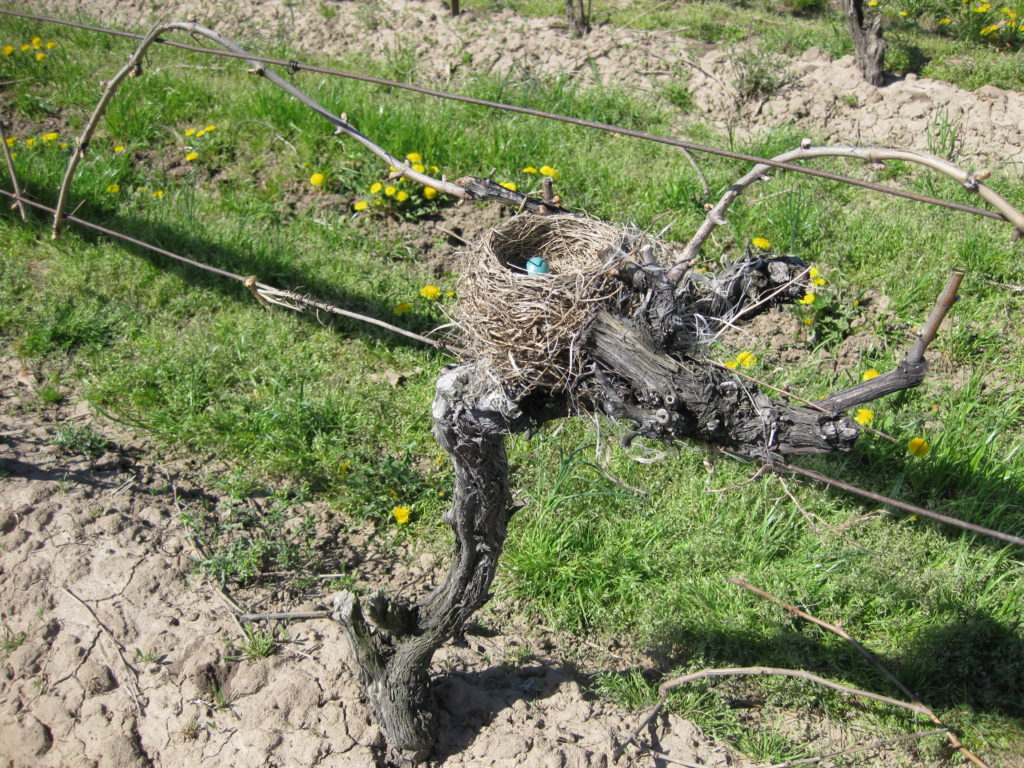
Cautiously creeping closer, it became evident that a determined Robin had chosen one of my oldest Pinot vines as the perfect place to raise its family. I recognized the irony in this nest full of future grape-pecking Robins staring me in the face, but I couldn’t bring myself to relocate the cosy looking abode. Instead, I tied down the canes and snapped a few quick pictures as mama Robin chirped at me rather aggressively from two rows away.

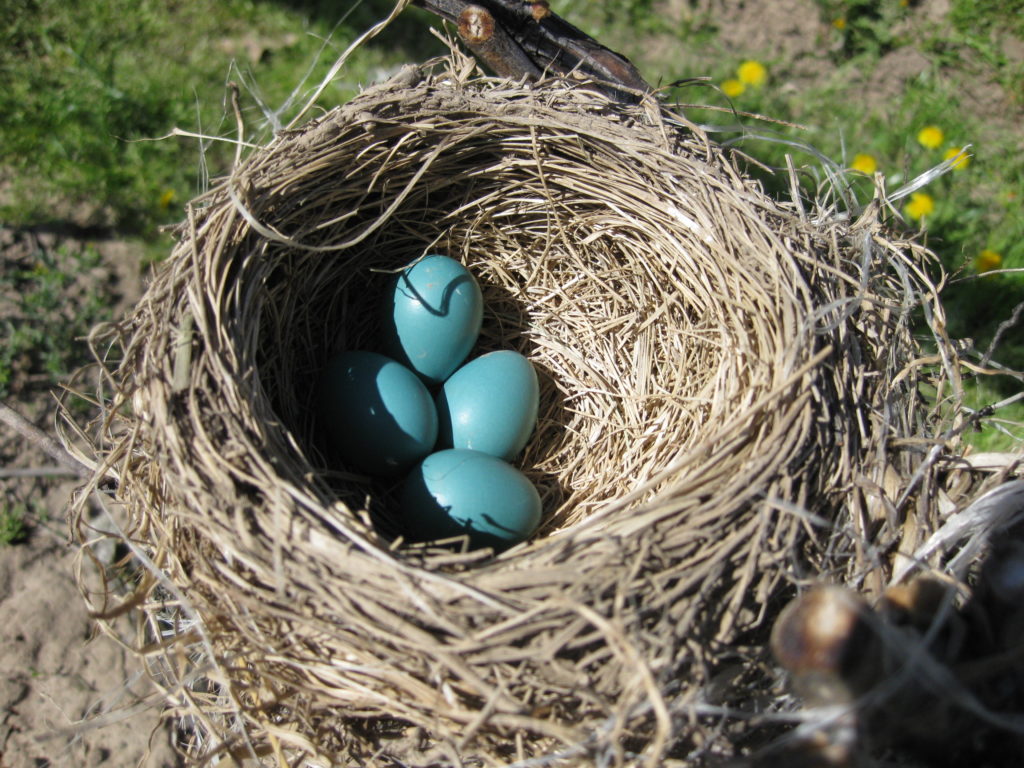
This is actually a common vineyard occurrence. The most interesting discoveries are the camouflaged Kildeer nests dotting the ground between grapevines. Mother Killdeers are seemingly fearless. As you approach the nest she will frantically charge at you, feigning a broken wing in an effort to seem more vulnerable to the perceived predator. In the ultimate act of altruism the mother will then attempt to lead you in the opposite direction of her nest, all the while fanning her “broken” wing. I always get a kick out of this evolutionary trait and try to vacate the area as quickly as possible. Inevitably, I must approach the nest as work continues in the adjacent row and the whole dance starts again.
My mind flashes to a vision of yours truly, arms flailing and yelling wildly, as Howie approaches one of my dogs on the tractor. He is blissfully unaware, and they are all too eager to greet him. Finally, I get his attention and danger is averted. My inner Kildeer is satisfied.
Rainy Day, Peace of Mind
As I sit here in the barn on a rainy day in April, find staring at stacks and stacks of unlabelled and unwaxed bottles…I feel a strange sense of calm. With the stresses of bottling now past, I wistfully look forward to the 2013 growing season and the six exciting new wines we’ll soon be introducing to our guests.
In stark contrast to 2012, spring conditions have been consistently cool to this point. That’s just fine with most grape growers, who would rather see their buds emerge slowly from a long winter slumber. Eager buds mean sleepless nights for farmers and especially those in charge of operating wind machines. The week of rain we are currently experiencing is actually much needed to help replenish water tables and soil moisture levels before we’re faced with the rigours of summer heat.
Rainy days are also great for catching up on things like racking, labelling, waxing and for reflecting (i.e. blog writing); like right now when I glance over at my three dogs cuddled up on the floor and find myself smiling, warmed with a happiness bordering on tearful pride. These dogs have come to mean a lot to me, and I consider myself very lucky to be able to bring them to work every day.
The mere fact that I’ve accumulated this fur triumvirate speaks to my personal weakness for saying no to rescue animals (don’t ask how many cats we have). Three dogs can be a handful – especially three of this ilk. They are equal parts cute, crazy and vision impaired. A fixture in the barn, they are usually adored and doted on by our guests. One soon learns, however, that excited dogs, cheese platters and fine stemware don’t mix. Despite their shortcomings, I am fully aware that these three have given me far more than I will ever be able give to them.
A big change is that I’m now forced to take lunch breaks, a rarity prior to their arrival. To be responsible for living creatures has been a wake-up call of sorts, although many times that call comes way too early in the morning in the form of a blood-curdling Nova Scotia Duck Toller scream (Google it). The lighter moments they supply are a welcome distraction from the inevitable hail storms, bottle shock, mildew, rotten Pinot Noir and determined starlings that I always seem to be worrying about. Come to think of it, they even help ward off those pesky starlings! Most importantly they make me stop and enjoy life, for both human and dog years go by way too quickly.
Over the coming weeks I’ll be posting the vinification notes for each of our six new wines and sending out an email order request to all those who’ve left their contact information in our guest book. In the meantime, dedicated followers of this blog are welcome to pre-order any of our 2010 reds or 2012 whites they would like (wes@fiverows.com). They should be ready for pick-up by May 1st.
Treadwell Dinner
Rounding up the family and heading out to a fancy dinner is a foreign experience for many farmers. The Clampett’s…err…Lowrey’s are no exception, and really don’t get out much. My own culinary expertise is limited to impeccably microwaved Michelina’s (down to the second!) and hastily constructed lunchtime wraps.
“Pa”, however, puts me to shame with his mastery of outdoor, open-flame cooking. He is aloof in the kitchen, but can skillet fry just about anything over his gnarled pile of burning grape trunks. I once saw him make perfect toast using welding gloves, a long-handled frying pan and diesel fuel. He ended the show by flipping eggs with a one-iron (he could never hit it anyway).
Suffice it to say, we always jump at the chance to get dolled up and host a civilized Winemaker’s dinner every year at Treadwell’s. Thankfully for the patrons, we are only responsible for bringing the wine. Seriously, we treasure the opportunity to share this annual experience with so many of our supporters. The signed menu, seen below, has become a treasured memento for us, growing in names each year. It’s something we display with pride in our barn and reflect on fondly with many of our guests.
As you can see, this year’s menu was a masterpiece. I can easily recall the distinct flavours of each dish as I write this, a sure sign of a wonderfully skilled kitchen and chef. My compliments to James and the entire staff for the seeming ease at which they managed each course.
Of the wines I tried on this evening, the 2008 Syrah was a highlight for me – perhaps for sentimental reasons. We decided to raid the cellar and bring our last case to share on this appropriate occasion. The smoked duck was an astute pair, picking up on the smoky, earthy and savoury elements of the Syrah. Many commented on how much the flavours and mouthfeel had changed since they last tried it. The classic Syrah pepper, earth and floral elements were still there, but the once subtle dark fruit components had come to the fore both aromatically and on the palate. It leads me to think that this wine is probably best consumed during this exciting time in its evolution (for those who still have a bottle).
The sumptuous “pulled pork” course might have been James’ nod to our participation in the most recent Pigs and Pinot celebration in Healdsburg, California. My parents were thrilled to visit Sonoma and represent Canada at the “Pinot Smackdown”, which they managed to escape without a scratch.
We ended the night with a barrel sample of the 2012 Sauvignon Blanc. I figured this was appropriate given that Sauvignon Blanc is, in many ways, the reason we have forged such a strong relationship with Treadwell’s. The feedback was promising with many not letting me leave without guaranteeing them at least a six-pack.
The 2012 has a ripe nose very reminiscent of the 2010, which makes sense because both were generally warm, dry years. The mouthfeel and flavours were still a work in progress though, following bentonite fining, cold stabilization and possibly ongoing malolacitc fermentation. As with most classy dames she didn’t want to give away all her secrets on the first date!
A heartfelt thanks to all who attended.
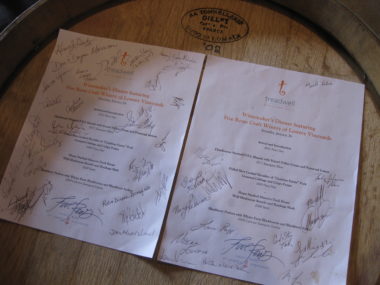
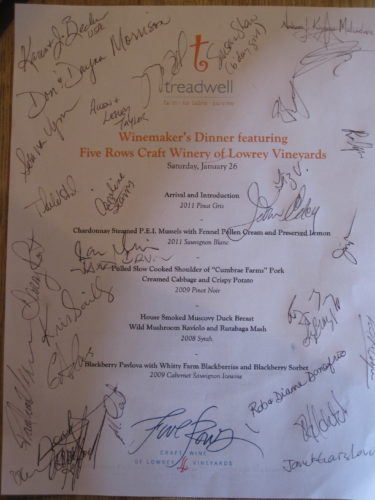
Winter Events
We can now announce some details regarding a couple of exciting winter events we have in the works.
Firstly, I am floored by the response to our Treadwell’s Winemaker Dinner on January 26. Based on the turnout to previous dinners, James and I had anticipated the usual 25-30 loyal Five Rows fans who had joined us in the past. However, within a week of the dinner announcement this year it became apparent that we were going to need a bigger boat. The enthusiastic request for seats meant the entire restaurant would have to be closed down to accommodate our ever-expanding group of friends.
What a great night it should be! I’ve had a chance to preview the proposed menu and can report that Stephen and James have outdone themselves yet again. The wines we have chosen to showcase are: 2011 Pinot Gris, 2011 Sauvignon Blanc, 2009 Pinot Noir, 2008 Shiraz and 2009 Cabernet Sauvignon Icewine. Most of these wines have been sold out for a while, so we had to source them from Wilma’s personal library (it took some convincing). I also plan to bring along a surprise barrel sample, as this was very well received last year. Any requests?
The 25th Anniversary Cuvée Celebration will take place March 1-3rd. In an effort to reflect the nostalgic theme this year, we’ve decided to dip into our library for the Cuvée En Route tasting sessions. Anyone wishing to visit us over that weekend is invited to participate in the first ever Five Rows Pinot Noir vertical tasting, featuring wines from 2007, 2008 and 2009. I hope to collect some useful feedback to better advise those who’ve resisted temptation and continue to age these wines in their cellar. Please email or call if you plan to stop in over the weekend so we can determine how many bottles might be required.
New Year, New Sign
I feel it fitting, in this my 100th blog entry, to festively announce the erection of a new Five Rows roadside sign.
I can hear you all in unison: “Well, it’s about time!”
However, it is not without some sentimental regret that we retire our old red sandwich board. At various times it was stolen, returned, run over, blown over, repainted, amusingly observed by Beppi and cursed by all those who didn’t see it on first pass. A useful (if not reliable) sign it was.
As is evident in the following photographic essay, the beautiful new sign was hung with typical Five Rows grace and ingenuity. I ask anyone working for the Ontario Workplace Safety Insurance Board to kindly avert your eyes. A special thanks to Barry Imber for his fine craftmanship.
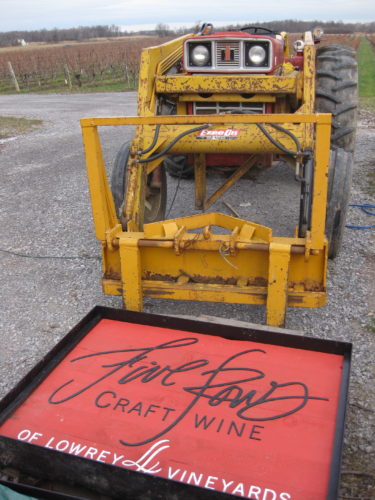

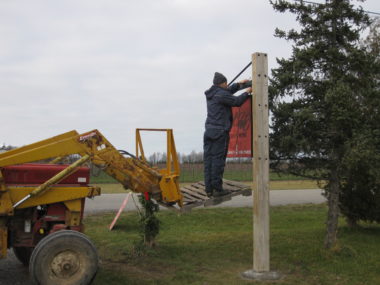

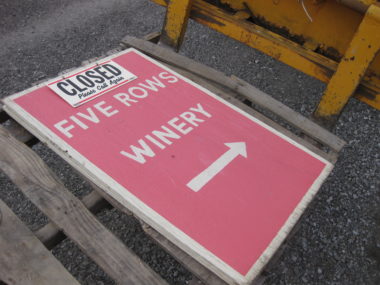
I wish you all a Happy New Year and invite you to join us for our third annual Treadwell’s Winemaker Dinner on January 26th, 2013. Wine pairing details coming soon!
Happy Holidays
The relaxing afterglow experienced at the end of a vintage presents a great time to reflect on the many wonderful visitors we’ve hosted over the past year. Some are returnees who’ve come to pick up their treasured order, others stumble upon us while searching for another winery and a few brave souls even traverse unimproved roads determined to reach their destination. It is a testament to every single one of you that our tiny winery has become a pilgrimage for wine lovers from around the world!
It’s easy for us to say we plan to grow by “word of mouth”, but without the right “words” and “mouths” – it just doesn’t work. We thank you for being that “mouth”, a true Five Rows ambassador! All of you have helped to make our tasting room a rewarding place to spend our weekends.
Each year we’ve attempted to make a few more cases of wine to keep up with demands and stretch quantities through to our spring bottling date. Consequently, our production is up to 750 cases in 2012. Thanks to your enthusiasm and generosity we are down to the final 40 cases of both 2009 Pinot Noir and 2009 Cabernet Sauvignon Icewine – everything else is sold out. Christmas orders and deliveries can still be arranged if you would like.
We look forward to having you taste the 2012 whites and much-anticipated 2010 reds next spring. Expect a release announcement and order request on or around May 1st. As in previous years, we will not have regular weekend retail hours from January through March (apart from Cuvee weekend March 1-3). Appointments can still be arranged anytime. In fact, the barn can get quite lonely over the winter so don’t make yourself a stranger!
“Off With The Cabs!” (and hurry)
Never in my experience as a Viticuluralist has the end of a growing season been so clearly defined. A couple of weeks back I glanced at the long term forecast and didn’t like what I saw. As the resulting “Frankenstorm” began taking shape, the decision to harvest our last fruit of the season on Friday, October 26th was an easy one.
The sunny and warm conditions we experienced that day belied the imminent storm hovering in the Atlantic. We happily snipped clusters and reminisced about the unique season we had just experienced. Unprecedented heat and prolonged periods of drought combined to give us the ripe grapes we now toted to the wagon. Slowly but surely, the five rows I had chosen for our 2012 Cabernet Sauvignon graciously handed us their bounty. As usual, we harvested three rows from our younger Clone 169 Block and two rows from our trusty “Old Block”. I’ve come to appreciate that these two vineyards complement one another very well. I count on the Clone 169 vines for the ripe, dark fruit characters, while the old block always supplies a uniquely elegant structure.
As we set up the crush pad later that afternoon, I was struck by the harmonious way old vintages seem make way for new ones. Just as the 2012 Cab Sauv grapes were processed into bins in the back of the barn, the last few cases of 2009 Cab Sauv were making a hasty exit out the front door! The interior floor space freed up by these case sales was much needed for the incoming bins. A second example arises as the 2012 Shiraz finishes fermentation. It would need to be pressed soon, meaning the 2010 Shiraz must be racked out of barrel and blended, so the wood can be re-used to house the pressed 2012’s. This poetic cycle appeals to my love of order and flow – one in, one out. The fact that 2010 and 2012 were very similar growing seasons deepens the bond between these two wines that now share both lineage and cooperage.
I would like to thank all the people who have braved the wet weather to pay us a visit over the busy months of harvest. I apologize to those “first-timers” who came at a time when our once plentiful stacks were now gone or critically low. We do still have limited quantities of 2009 Pinot Noir and 2009 Cab Sauv Icewine available, and we plan to stay open for tastings until Christmas. Please stop in if you have a chance.
Cheers to a great vintage!!
